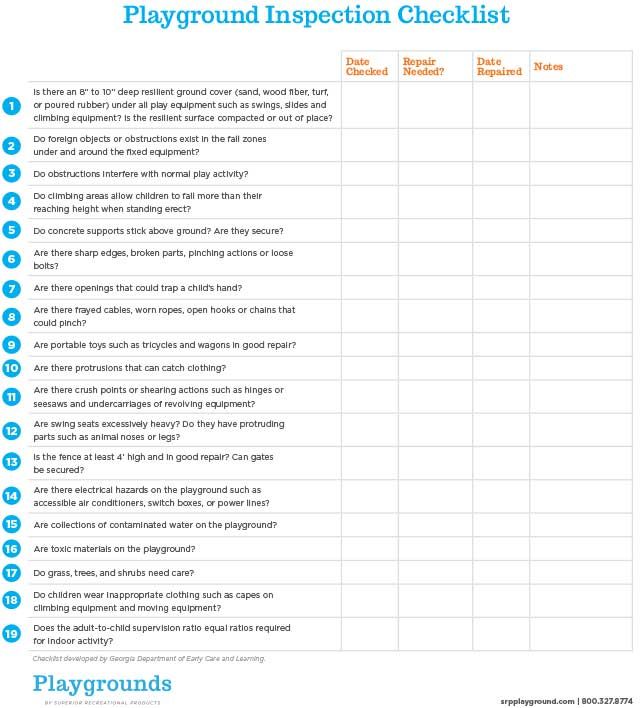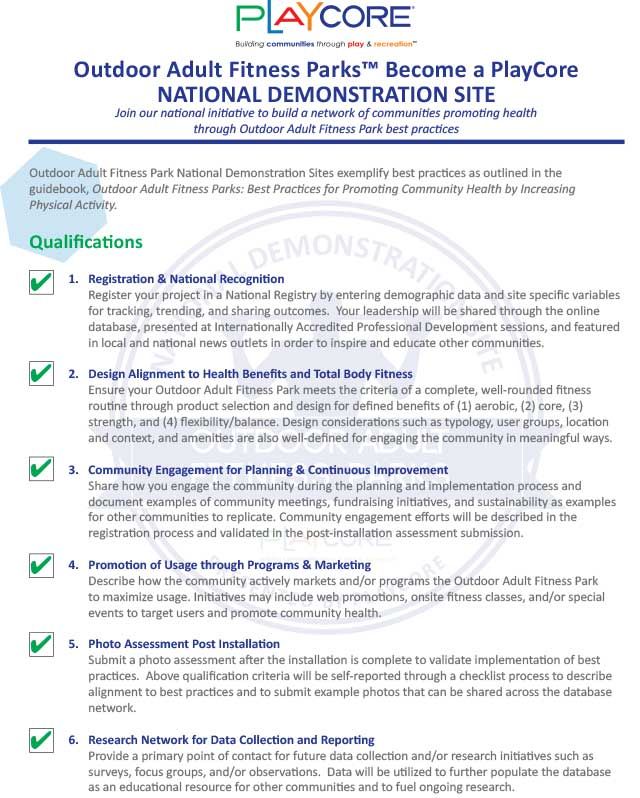Safety
The Dirty Dozen Checklist
The surface or ground under and around the playground equipment should be soft enough to cushion a fall. Improper surfacing material under playground equipment is the leading cause of playground related injuries. Over seventy percent of all accidents on playgrounds are from children falling. Hard surfaces such as concrete, blacktop, packed earth or grass are not acceptable under play equipment. A fall onto one of these hard surfaces could be life threatening.
There are many surfaces that offer protection from falls. Acceptable surfaces are hardwood fiber/mulch, sand, and pea gravel. These surfaces must be maintained at a depth of twelve inches, be free of standing water and debris, and not be allowed to become compacted. There are also synthetic or rubber tiles and mats that are appropriate for use under play equipment.
A fall zone or use zone is under the area under and around the playground equipment where a child might fall. A fall zone should be covered with protective surfacing material and extend a minimum of six feet in all directions from the edge of stationary play equipment such as climbers and chin up bars. The fall zone at the bottom or exit area of a slide should extend a minimum of six feet from the end of the slide for slides four feet or less in height. For slides higher than four feet, take the entrance height of the slide and add four feet to determine how far the surfacing should extend from the end of the slide. Swings require a much greater area for the fall zone: The fall zone should extend two times the height of the pivot or swing hanger in front of and behind the swings seats. The fall zone should also extend six feet to the side of the support structure.
A protrusion hazard is a component or piece of hardware that might be capable of impaling or cutting a child if a child should fall against the hazard. Some protrusions are also capable of catching strings or items of clothing which might be worn around a child’s neck. This type of entanglement is especially hazardous because it might result in strangulation. Examples of protrusion and entanglement hazards include bolt ends that extend more than two threads beyond the face of the nut, hardware configurations that form a hook or leave a gap or space between components and open “S” type hooks. Rungs or handholds that protrude outward from a support structure may be capable of penetrating the eye socket. Special attention should be paid to the area at the top of slides and sliding devices. Ropes should be anchored securely at both ends and not be capable of forming a loop or a noose.
Enclosed openings on playground equipment must be checked for head entrapment hazards. Children often enter openings feet first and attempt to slide through the opening. If the opening is not large enough it may allow the body to pass through the opening and entrap the head. Generally, there should be no openings on playground equipment that measure between three and one half inches and nine inches. Where the ground forms the lower boundary of the opening is not considered to be hazardous. Pay special attention to openings at the top of a slide, openings between platforms and openings on climbers where the distance between rungs might be less than nine inches.
Improper spacing between pieces of play equipment can cause overcrowding of a play area which may create several hazards. Fall zones for equipment that is higher than twenty-four inches above the ground cannot overlap. Therefore there should be a minimum of twelve feet in between two play structures. This provides room for children to circulate and prevents the possibility of a child falling off of one structure and striking another structure. Swings and other pieces of moving equipment should be located in an area away from other structures.
Trip hazards are created by play structure components or items on the playground. Exposed concrete footings, abrupt changes in surface elevations, containment borders, tree roots, tree stumps and rocks are all common trip hazards that are often found in play environment.
The supervision of a playground environment directly relates to the overall safety of the environment. A play area should be designed so that it is easy for a parent or caregiver to observe the children at play. Young children are constantly challenging their their own abilities, very often not being able to recognize potential hazards. It is estimated that over forty percent of all playground injuries are directly related to lack of supervision in some way. Parents must supervise their children in some way on the playground!
Children’s developmental needs vary greatly from age two to age twelve. In an effort to provide a challenging and safe play environment for all ages it is important to make sure that the equipment in the playground setting is appropriate for the age of the intended user. Areas for pre-school age children should be separate from areas intended for school age children.
For playgrounds to remain in “safe’ condition a program of systematic, preventive maintenance must be present. There should be no missing, broken or worn-out components. All hardware should be secure. The wood, metal, or plastic should not show signs of fatigue or deterioration. All parts should be stable with no apparent signs of loosening. The surfacing material must also be maintained. Check for signs of vandalism.
Components in the play environment should be inspected to make sure there are no sharp edges or points that could cut skin. Moving components such as suspension bridges, track rides, merry-go-rounds, see-saws and some swings should be checked to make sure that there are no moving parts or mechanisms that might crush or pinch a child’s finger.
Elevated surfaces such as platforms, ramps, and bridgeways should have guardrails that would prevent accidental falls. Preschool age children are more at risk from falls and equipment intended for this age group should have guardrails on elevated surfaces higher than twenty inches. Equipment intended far school-age children should have guardrails on elevated surfaces higher than thirty inches.
Accidents associated with the following types of equipment have resulted in the Consumer Product Safety Commission recommending that they not be used on public playgrounds:
- Heavy swings such as animal figure swings and multiple occupancy/glider type swings.
- Free swinging ropes that may fray or form a loop.
- Swinging exercise rings and trapeze bars are considered athletic equipment and not recommended for public playgrounds. Overhead hanging rings that have a short amount of chain and are intended for use as a ring trek (generally four to eight rings) are allowed on public playground equipment.
 VIEW CATALOGS
VIEW CATALOGS
